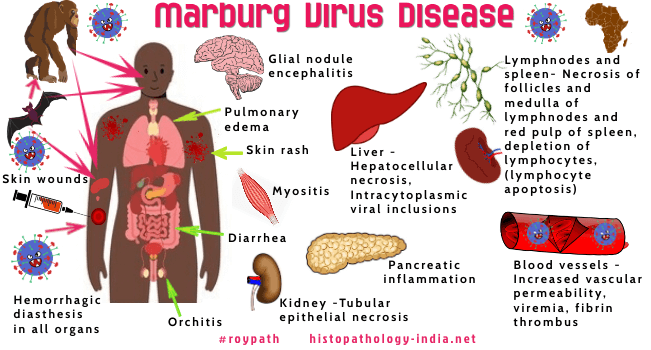|

Custom Search
|
|
Infectious Disease Online Pathology of Marburg Virus Disease (Marburg Hemorrhagic Fever)
|

| The Marburgviruses (family
Filoviridae; genus Marburgvirus)
are single-stranded RNA viruses that cause sporadic outbreaks of severe
hemorrhagic fever in humans. Marburg virus disease (MVD) is characterized
by rapid onset, person-to-person transmission and a high case fatality
rate.
|
|
Syn: Green-monkey-disease Marburg virus (MARV) is the causative agent of Marburg virus disease (MVD) in humans, Marburg virus disease, a severe, distinctive, hemorrhagic illness with a high rate of mortality, is heralded early by severe sore throat, a maculopapular rash, and a red exanthem on the hard and soft palate. Later, severe, generalized bleeding dominates the clinical course. As the intensity of the disease increases, the features may include a maculopapular rash spreading from the torso to the limbs, conjunctivitis, sustained fever, and symptoms of hemorrhagic fever, such as mucosal bleeding, petechiae, blood in the stool and vomitus, and bleeding from venipuncture sites. The maculopapular rash begins as small, dark red spots around hair follicles of the trunk and sometimes upper arms, developing into a diffuse rash, and can become a dark erythema that covers the face, neck, chest, and arms. Patients that survive may experience symptoms of arthritis, conjunctivitis, myalgia, and symptoms of psychosis during and after recovery. The disease was first recognized in 1967 in Marburg, Germany, and Belgrade in the former Yugoslavia, among laboratory workers exposed to blood and tissues from African green monkeys imported from Uganda. There have been subsequent outbreaks in South Africa, Kenya, and Zimbabwe. The Marburg and Ebola viruses are interpreted as the first recognized viruses of the family, the Filoviridae. Marburg hemorrhagic fever has affected many fewer persons than Ebola virus. Thus, the outbreak that was declared over in November 2005 was of particular interest, especially since before this outbreak, cases in children were rare, and in this outbreak, children account for a high proportion of those affected. Transmission of these viruses occurs by direct contact with infected body fluids from animals and humans, such as blood, saliva, vomitus, respiratory droplets, urine and stool, and contact with virus-contaminated objects (e.g. needles, syringes). Several bat species have been implicated in being a reservoir host for filoviruses, and there is strong evidence that Rousettus aegyptiacus, the Egyptian fruit bat, serves as a reservoir for MARV. Persons who prepare, cook, and eat contaminated animals may become infected. Person-to-person transmission occurs, as does infection from direct inoculation. Transmission via semen may occur weeks after recovery. Pathology - Autopsies have demonstrated focal necrosis without inflammation in the liver, spleen, testes, ovaries, and the pancreas, and signs of hemorrhagic diatheses in all organs. Glial nodule encephalitis has been noted throughout the brain. Significant renal damage and signs of tubular insufficiency also occur. Lymphatic tissue demonstrates plasmacellular and monocytoidal transformation. Basophilic bodies have been noticed near necrotic cells or as inclusion bodies in parenchymal cells. It is extremely important to use proper barrier nursing techniques to prevent secondary cases of Ebola and Marburg virus hemorrhagic fevers to caretakers and families, including use of standard, contact, and airborne isolation precautions. There is also concern about use of the filoviruses as bioterror agents, especially if the viruses could be modified to efficiently spread via aerosol from person-to-person. Visit: Ebola Virus Disease ; Lassa Fever. |
|
|
Copyright © 2022 histopathology-india.net

